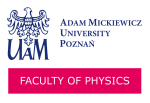27.1.2022
Between waves and patterns: space-time magnonic crystals and freezing of spin waves in films with Dzyaloshinskii-Moriya interaction and perpendicular anisotropy
Dr Paweł Gruszecki
Date, Time
27.01, 15:00 - 16:00
Location
Link to MSTeams meeting
Abstract:
Wave propagation in homogeneous media is known and well described by a dispersion relation. The periodic modulation, usually made with some lithography processes, introduces effects predicted by the Bloch theorem, which are widely exploited with photonic crystals and their magnetic counterparts, magnonic crystals. Interestingly, in ferromagnetic materials, space discrete translational symmetry can be introduced also with the periodic magnetization texture, without any structurization. This direction of research promises the formation of magnonic crystals on demand, with a high degree of reconfigurability and offering dynamical tuning [1,2].
The concept of symmetry breaking can also be applied to time and the idea of systems with broken translational symmetry in both space and time, so-called space-time crystals, was proposed by F. Wilczek in 2012 [3]. Using scanning transmission X-ray microscopy we experimentally demonstrate at room-temperature and explain with micromagnetic simulations, the formation of a dynamical magnetic pattern characterized by a periodicity in both time and space in a thin permalloy stripe pumped by a spatially uniform microwave field [4]. Such a system can be considered as a driven space-time magnonic crystal (STMC). Moreover, we demonstrate an interaction of magnons with this STMC, resulting in the appearance of 100 nm long spin waves that are much shorter than the waves expected from the dispersion relation of the uniformly magnetized permalloy stripe at the pumping frequency. We show that this short wave originates from the second Brillouin zone of the magnonic band structure of the driven STMC. This finding clearly confirms the dynamical formation of the periodicity in space in a homogeneous ferromagnetic element and demonstrates that the dynamical magnetization pattern forms a suitable environment for Brillouin-type scattering of spin waves.
Acknowledgments
The research has received partially funding from the Polish National Science Centre project No. 2019/35/D/ST3/03729.
References:
[1] C. Banerjee et al., Phys. Rev. B 96, 024421 (2017).
[2] P. Gruszecki et al., Chapter 2, Solid State Physics 70, 1 (2019).
[3] F. Wilczek, Phys. Rev. Lett. 109, 160401 (2012).
[4] N. Träger et al., Phys. Rev. Lett. 126, 057201 (2021).

